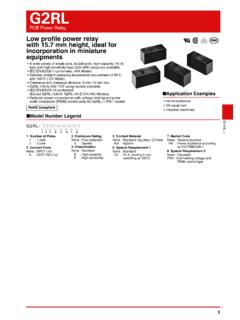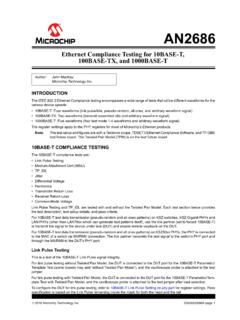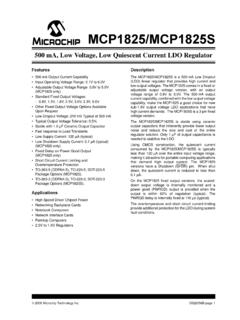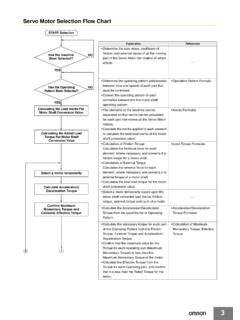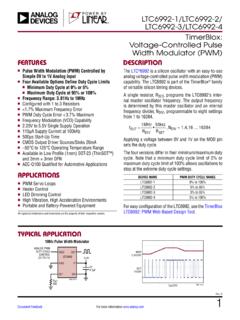Transcription of TIPS & TRICKS ON DOUBLE PULSE TESTING - Rohde & Schwarz
1 Application Note TIPS & TRICKS ON DOUBLE PULSE TESTING From designing a test setup to performing accurate measurements DOUBLE PULSE TEST Products: R&S RTO2000 R&S RTE1000 R&S RTA4000 R&S RTM3000 R&S HMF2550 Jens Schweickhardt, Kevin Hermanns (PE-Systems), Dr. Markus Herdin (R&S) | GFM347 | Version | Rohde & Schwarz | Application Note Tips & TRICKS on DOUBLE PULSE TESTING 2 Contents Abbreviations .. 3 List of Nomenclatures .. 4 1 Overview .. 6 2 DOUBLE PULSE Test .. 7 Test Procedure ..8 Measurement Parameters .. 11 Switching Times , , .. 11 Switching Energy , .. 11 Reverse Recovery Characteristics of Freewheeling Diode.
2 12 Effect of Parasitic Components .. 12 Design of Circuit Parameters .. 16 Dimensioning the Load Inductor .. 16 Dimensioning the Capacitor Bank .. 18 3 Voltage and Current Measurement .. 20 Voltage Measurement Probes .. 21 Current Measurement .. 22 De-skew .. 24 Common Mode Rejection Ratio (CMRR) .. 25 4 Measurement Setup and Results .. 27 Details of Measurement Setup .. 27 Test Results .. 28 Switching Transients .. 28 5 Conclusions .. 35 6 References .. 36 Rohde & Schwarz | Application Note Tips & TRICKS on DOUBLE PULSE TESTING 3 Abbreviations DPT DOUBLE PULSE Test DUT Device Under Test AWG Arbitrary Waveform Generator IGBT Insulated Gate Bipolar Transistor MOSFET Metal Oxide Semiconductor Field Effect Transistor ESR Equivalent Series Resistance ESL Equivalent Series Inductance Rohde & Schwarz | Application Note Tips & TRICKS on DOUBLE PULSE TESTING 4 List of Nomenclatures B Capacitance of the capacitor bank DD Parasitic capacitance of freewheeling diode DS Drain-source capacitance of DUT GD Gate-drain capacitance of DUT GS Gate-source capacitance of DUT EC Energy of capacitor bank EL Energy of load
3 Inductor on Turn-on energy loss off Turn-off energy loss rr Reverse recovery energy D Drain current load Load current rr Reverse recovery current Test Test current Current drop Bus, Parasitic inductance of bus bar / PCB connecting the capacitors with the DUT D Parasitic drain inductance G Gate inductance load Inductance of the load inductor S Parasitic source inductance sense Parasitic inductance of the measurement device G Gate resistance S Parasitic series resistance of load inductance d(on) Turn-on delay time d(off) Turn-off delay time f Fall time r Rise time rr Total reverse recovery time DC DC-link voltage (Test voltage) f Diode forward-voltage DS Drain-source voltage DC DC-link voltage drop 1 Duration of first PULSE Rohde & Schwarz | Application Note Tips & TRICKS on DOUBLE PULSE TESTING 5 break Duration of PULSE break 2 Duration of second PULSE Rohde & Schwarz | Application Note Tips & TRICKS on DOUBLE PULSE TESTING 6 1 Overview In modern societies, a substantial amount of electrical energy is required for the operation of electronic circuits or controlled electrical drives.
4 The requirement of electrical energy for these applications is fulfilled by power electronic converters. Power semiconductors (IGBT or MOSFET) are controlled devices, which are used to realize these converters. Even though the semiconductor industry has made a significant progress in the development of powerful and efficient components, power losses still occur in these components and cause them to heat up. The junction temperature of a semiconductor has to be kept below a maximum permissible limit. Furthermore, heating up and cooling down have a strong influence on the lifetime of a semiconductor device. This so-called thermal cycling is another important aspect for the design of a cooling system. In order to design an effective cooling system, it is necessary to know the power losses occurring during the operation of a circuit as precisely as possible.
5 These losses are composed of conduction and switching losses. While the conduction losses can be measured relatively easily, this is not so easy for switching losses. Figure 1 depicts one phase of a typical two-level converter. During a fundamental cycle, the operation of the converter changes between buck and boost mode, depending on the direction of current flow. The switching operation of the converter creates commutation events from switch to diode or vice versa in each mode. If the converter operates in buck mode, S1 and D1 are active. In boost mode, the current commutates between S2 and D2. Consequently, a setup is required which allows the measurement of switching losses and switching times for all aforementioned commutations.
6 Here the DOUBLE PULSE test comes into play. Figure 1: Two level converter and its operation modes. This application note describes the basic concept of DOUBLE PULSE TESTING , the necessary measurement setup and gives an overview of the parameters influencing the measurement. Furthermore, practical tips for carrying out the measurement are presented. At this point, the reader is referred to the software application included in the application note, which allows to easily perform DOUBLE PULSE tests with Rohde & Schwarz instruments. Rohde & Schwarz | Application Note Tips & TRICKS on DOUBLE PULSE TESTING 7 2 DOUBLE PULSE Test The knowledge of the switching behavior of power semiconductor devices is crucial when it comes to the design of power converters.
7 DOUBLE PULSE tests are carried out to determine the switching times and switching losses as well as to ensure a proper switching behavior. For TESTING all converter states, the basic circuitry of the two-level converter is kept (DC-Link, switches and load inductor) but the load voltage source 2 in Figure 1 needs to be replaced by a short circuit. For TESTING the switching events in the buck mode of the converter, the short circuit connects the load inductor between the mid-point (load terminal) and the minus rail (depicted in Figure 2). For the boost mode, the load inductor is connected to the plus rail. Figure 3 shows the basic circuit diagram for DOUBLE PULSE TESTING . The blue arrows between active and freewheeling state mark the commutations happening between these two states by each switching event.
8 In the following, turn-on refers to the turn-on event of the switch ( 1 or 2) which results in a commutation of the current from the diode to the switch (freewheeling to active state). Accordingly, turn-off refers to the turn-off of the switch and results in a commutation of the current from the switch to the diode (active to freewheeling). Depending on the design of the DUT, measurements are to be performed on the high-side or low side-side device. 1 or 2 are the high-side devices while 1 or 2 are low-side. In a half-bridge module, for example, the current paths in the upper and lower part of the module are not necessarily symmetrical. In this case, the switching behavior of the two semiconductors deviates from each other.
9 Therefore, measurements must be performed for both devices. The different causes for the deviation will be described in section In a DOUBLE PULSE Test (DPT), the DUT can either be the switch or the diode. Additionally, the switch can either be a MOSFET or an IGBT. In this document, the test is performed using a MOSFET, however, if an IGBT is used, the drain and source in a MOSFET can be treated analogously to emitter and collector of IGBT. Figure 2: Overview of the DOUBLE PULSE test circuit-configuration for buck- and boost-mode test Rohde & Schwarz | Application Note Tips & TRICKS on DOUBLE PULSE TESTING 8 A typical DOUBLE PULSE test setup consists of the following hardware components: Device under test (DUT) Freewheeling diode (D) DC supply DC link capacitor bank ( B) Load inductor ( load) Gate driver circuit Arbitrary Waveform Generator (AWG) Oscilloscope Measuring sensors for current Measuring probes for voltage Heating element The basic setup including many of the components above can be found in Figure 3.
10 It should be noted that the measuring circuit shown is at floating potential. This increases the flexibility of the measurement, but is not possible with all setups. Figure 3: Circuit diagram of DOUBLE PULSE test Test Procedure In order to carry out the test, initially, the capacitor bank is charged to the desired test voltage via the power supply. The actual voltage has to be somewhat higher than the test voltage since the energy required to magnetize the inductive load must also be stored in the capacitor bank, resulting in some voltage drop during the first PULSE . When the required voltage value is reached, the power supply is disconnected from the capacitor bank. The measurement circuit is now at a floating potential.



